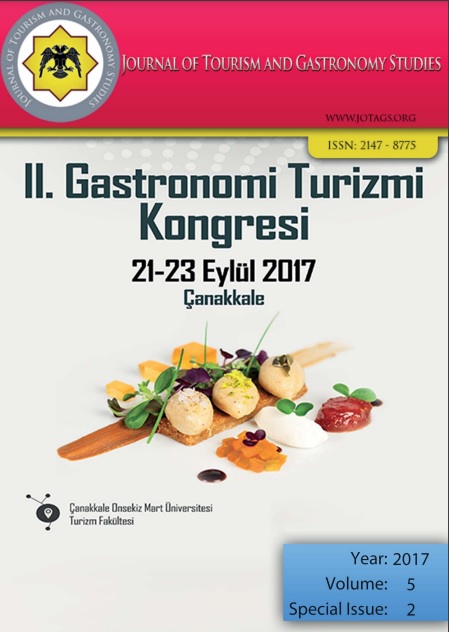Local Product Suggestion for Food and Beverage Operations: Çerez Tarhana
Keywords:
Local product, Çerez tarhana, Touristic establishmentsAbstract
In line with the industrial revolution, the globalizing world has caused radical changes in people's eating habits. That is why people are tempted to eat unhealthy, obesity-induced foods called fast foods. Fast food has become an important threat not only for human health but also for the local cuisines of the countries. At this point, studies are being carried out to include local products in eating habits both outside and outside. From this point, a pilot study has been carried out in order to make Maraş Tarhana into chips and to use it in tourist enterprises. The research consists of two phases. In the first step, tarhana chips were made and tested. In the second stage, the product was tested in two operations, and opinions of 103 customers were taken with a questionnaire consisting of open and closed end questions. Simple statistics and content analysis have resulted in a product that can be improved and that can be preferred by customers if their deficiencies are resolved.
References
Coşkun, F. (1996). Trakya'nın Değişik Yörelerinde Üretilen Ev Tarhanalarının Kimyasal, Mikrobiyolojik ve Duyusal Özellikleri Üzerine Bir Araştırma (Basılmamış Yüksek Lisans Tezi).Tekirdağ: Trakya Üniversitesi FBE.
Coşkun, F. (2014). Tarhananın tarihi ve Türkiye’de tarhana çeşitleri, Gıda Teknolojileri Elektronik Dergisi 9 (3): 69-79.
Funda, G. (2009). Ülkemizde Tüketilen Tarhanaların Mikrobiyolojik ve Bazı Kimyasal Özelliklerinin Analizi(Basılmamış Yüksek Lisans Tezi). Eskişehir: Anadolu Üniversitesi FBE.
Mil, B. ve Denk, E. (2015). Erzurum mutfağı yöresel ürünlerinin otel restoran menülerinde kullanım düzeyi: Palandöken örneği, Uluslararası Sosyal ve Ekonomik Bilimler Dergisi, 5 (2): 1-7.
Ögel, B. (1978). Türk kültür tarihine giriş.Ankara: Kültür Turizm Bakanlığı, Yayın No: 638.
Özçam, M. (2012). Cips Tarhananın Tekstürel ve Mikrobiyolojik Özelliklerinin Belirlenmesi(Basılmamış Yüksek Lisans Tezi). Manisa: Celal Bayar Üniversitesi SBE.
Saatcı, G. ve Demirbulat, Ö.G. (2016). Yöresel yemeklerin broşürlerde tanıtım unsuru olarak kullanılmasının analizine yönelik bir araştırma, Uluslararası Sosyal Araştırmalar Dergisi, 9 (42): 1999-2006.
Saldamlı, İ. (1983). Beslenme açısından fermente süt ürünleri,Gıda 8(6): 297-311.
Saldamlı, İ . (1998). Gıda kimyası.Ankara: Hacettepe Üniversitesi Yayınları.
Siyamoğlu, B. (1961). Türktarhanalarının yapılışı ve terkibi üzerinde bir araştırma. İzmir: E.Ü. Matbaası, No:44.
Şengül, S. ve Türkay, O. (2015). Bölge restoran menülerinin belirlenmesinde “yöresel mutfaklar” eğitiminin kullanılması: Mudurnu örneği, Elektronik Meslek Yüksekokulları Dergisi, UMYOS Özel Sayısı, 1-6.
Tangüler, H. ve Erten, H. (2009). Tarhana üretimi ve üretimde etkili olan mikroorganizmalar, II. Geleneksel Gıdalar Sempozyumu, 27-29 Mayıs, Van: 858-861,
TSE, (2004). TS 2282 Tarhana standardı.Ankara: Türk Standartları Enstitüsü.
Yıldırım, Ç. ve Güzeler, N. (2016). Tarhana cipsi,Nevşehir Bilim ve Teknik Dergisi,Targid Özel Sayısı:1-8.
Yörükoğlu, T. Dayısoylu, K.S. ve Gezgin, Y. (2012). Maraştarhanası. III. Geleneksel Gıdalar Sempozyumu, 10-12 Mayıs, Konya: 38-41.
Downloads
Published
How to Cite
Issue
Section
License
Copyright (c) 2023 Journal of Tourism & Gastronomy Studies

This work is licensed under a Creative Commons Attribution-NonCommercial 4.0 International License.








